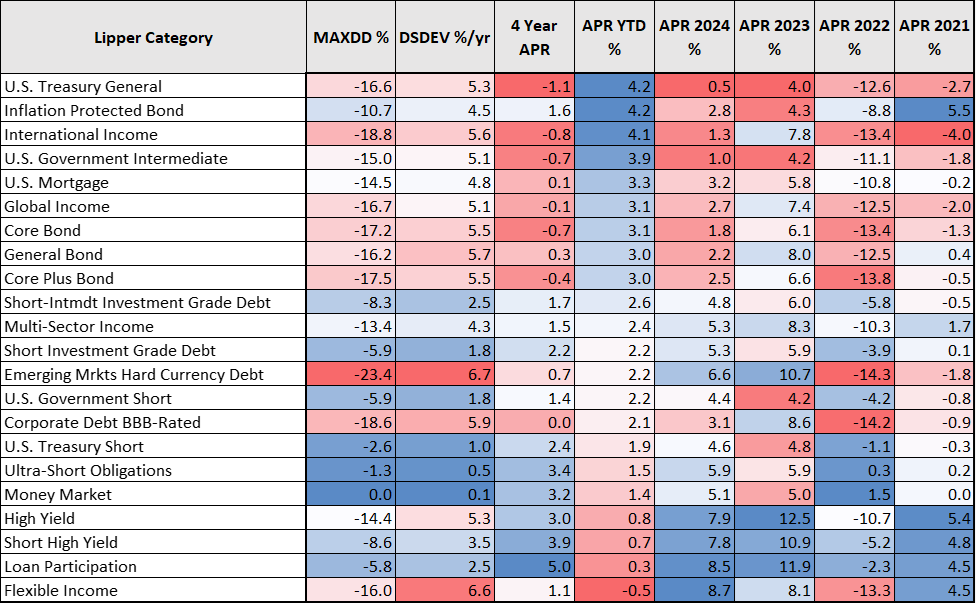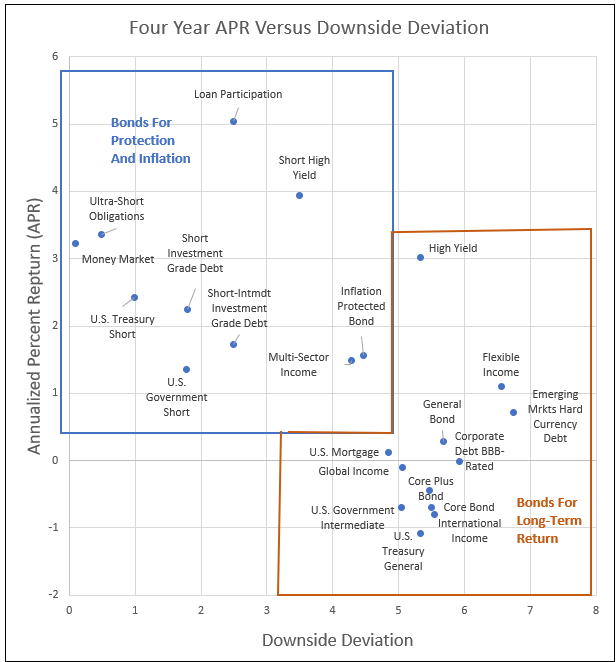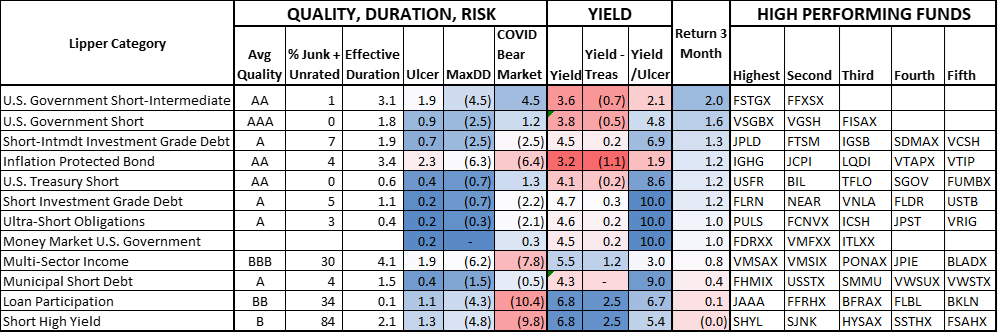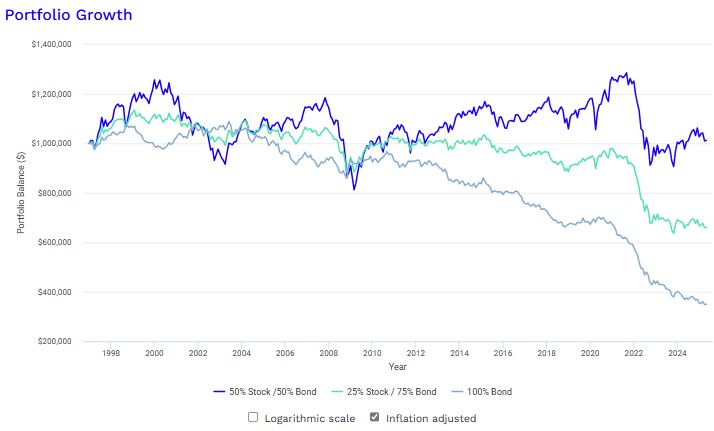I created my best laid plans of mice and men for retirement, or as Dwight D. Eisenhower said, “plans are worthless, but planning is indispensable”. I follow much of what Christine Benz recommends in How to Retire: 20 Lessons for a Happy, Successful, and Wealthy Retirement. I divide my intermediate investment bucket, consisting of Traditional IRAs, into conservative sub-portfolios of bonds that I manage and more aggressive sub-portfolios of stocks and bonds managed by Fidelity and Vanguard for growth and income. In this article, I look at managing withdrawals in a secular bear market with an elevated sequence of return risk.
This Time Is Different, Incredibly Different
Keynesian macroeconomic theory is to use government intervention to manage economic downturns and promote employment. The law of supply and demand means American consumers will spend less as tariffs are passed along in the form of price increases. Tariffs are a regressive tax on lower- and middle-income households. A broad measure of the dollar has declined by eight percent year-to-date, making imports even more expensive. Cutting Federal tax revenue more than spending adds to deficits and is financed with higher national debt. Businesses don’t like uncertainty, and those that don’t pass along the cost of tariffs will have lower profits, which pressures high valuations. This time is incredibly different!
I wrote Investing in 2025 and the Coming Decade for the Mutual Fund Observer December 2024 newsletter. Fidelity’s Asset Allocation Research Team (AART) described “a new environment of slower growth, increasing geopolitical risk, and declining globalization”. This was before tariffs were increased in April and before abrupt cuts to the Federal workforce and spending! I displayed Figure #1 below, which I created from Vanguard Perspective (October 22, 2024), to represent projected 10-year nominal returns and volatility. Investing in international equities and bonds helped investors with well-diversified portfolios sail through the 2025 correction with low volatility.
Figure #1: Vanguard VCMM 10-Year Return vs Volatility Projections
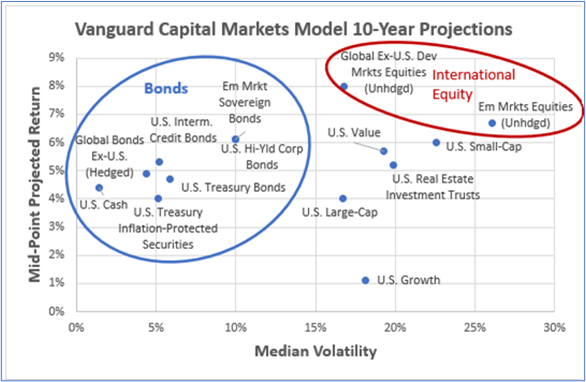
Source: Author Using Vanguard Perspective (October 22, 2024)
Uncertainty in retirement planning has greatly increased. Last month, while the stock market had recovered, I reduced my overall allocation of stocks to bonds from about 57% to around 50%. For a candid assessment of the risks, I refer you to “JPMorgan CEO Jamie Dimon Says Markets Are Too Complacent On Tariffs, Expects S&P 500 Earnings Growth To Collapse,” by Hugh Son at CNBC. To be clear, I favor a balanced budget in a well-thought-out manner over time. Uncertainty, whether strategic or not, will have lingering adverse effects.
Paolo Confino wrote, “As the Fed devises its new strategy, Powell sees an economy with ‘more volatile’ inflation,” for Fortune. Mr. Confino quotes Federal Reserve Chairman Jerome Powell as saying, “We may be entering a period of more frequent and potentially more persistent supply shocks, a difficult challenge for the economy and for central banks.” Mr. Powell continued, “Higher real rates may also reflect the possibility that inflation could be more volatile going forward than during the inter-crisis period of the 2010s.” Mr. Powell concludes, “Anchored expectations played a key role in facilitating these expansions. More recently, without that anchor, it would not have been possible to achieve a roughly five percentage point disinflation without a spike in unemployment.”
Lance Roberts at Real Investment Advice explains in “Earnings Revision Shows Sharp Decline” that earnings “estimates are exceedingly optimistic”. He suggested “rebalancing risk as necessary and adjusting portfolio holdings to provide some hedge against a sudden pickup in volatility”. Mr. Roberts points out that “as the economy slows, consumer demand falls”. One implication is that as the economy slows, tax revenues will slow, worsening the deficit and adding to the national debt.
Current Investment Environment
I watched “2025 Economy Watch,” by The Conference Board, and “Navigating Markets through a Shifting Sea of Policy” at Fidelity. They articulated my concerns for the economy very clearly. In Table #1, I compare the timely forecast from The Conference Board to the First Quarter 2025 Survey of Professional Forecasters by the Federal Reserve Bank of Philadelphia, which was made before the April 2nd announcement of tariffs. Economists at The Conference Board estimate that economic growth will probably slow to below 2% this year and next, and inflation will remain elevated near 3%.
Table #1: Forecasts of Real GDP and Inflation

Author Using Data from The Conference Board and Federal Reserve Bank of Philadelphia Survey of Professional Forecasters
The government bond sale this week was not met with enthusiastic investors, and the yield on 30-year Treasuries has risen from 4.4% following the April 2nd announcement of tariffs to over 5%. The 10-year Treasury has risen from 4.0% to nearly 4.6% during the same time as investors seek higher yields to compensate for inflation and uncertainty. The S&P 500 fell 1.6% that day.
Walmart recently announced that it would have to raise prices to offset tariffs. Walmart’s net operating profit margin is around 3%, and it depends on inventory turnover. They have little choice but to raise prices for consumers because of the cost of tariffs.
The recent GOP budget proposal is estimated to cost over $3T over ten years. “New Report: Rising National Debt Will Cause Significant Damage to the U.S. Economy” by the Peter G. Peterson Foundation, describes a study that estimates that the current path of growing national debt will, in the coming decades, reduce the size of the economy, the number of jobs, private investment, and wages. Moody’s became the last of the three major rating firms to lower the rating of US government debt, citing high deficits and rising interest costs.
Bonds For Conservative and Aggressive Buckets
I extracted performance data for the past five years of 723 bond and money market funds using MFO Premium fund screener and Lipper global dataset for all Fund Families loosely excluding those with performance ratings in the bottom quintile, those with less than $5B in assets under management, and those with fewer than five bond funds. The results are in Table #2. The data is color-coded with best as blue and worst as red. The worst-performing bond categories of the past four years became the best-performing of 2025 as of the time of this writing. I expect short-term interest rates to fall at the end of the year and long-term interest rates to rise, and tilt away from core bonds to those with shorter durations and inflation-protected bonds.
Table #2: Lipper Bond Category Performance by Year
Table #3 lists the Lipper Categories sorted by the highest returns to the lowest for 2021 to 2025, plus for the past four years. Funds in the Lipper Category below the dark red line had negative returns for the time period. The blue and gray shaded Categories were the most consistent high performers and suitable for a conservative fixed income portfolio. Those in the reddish and yellowish cells were less consistent and/or worse performers over the past four years. When inflation is high and long-term rates are rising, bonds with longer durations don’t perform well.
Table #3: Lipper Bond Category Performance by Year
Figure #2 shows the Annualized Percent Return (APR) for the past four years versus Downside Deviation. Those in the blue rectangle are the Lipper Categories that I would put in a conservative intermediate bucket sub-portfolio. Those in the orange shape are the more volatile Lipper Categories that may be suitable for a more aggressive intermediate bucket sub-portfolio.
Figure #2: Lipper Bond Category APR Versus Downside Deviation
Table #4 contains funds in the Lipper Categories for conservative bond portfolios as of mid-May. Yields for municipal bond funds are adjusted to the tax equivalent yield for an investor taxed at 22%. Bonds with shorter duration and inflation-protected bonds are trending higher.
Table #4: Author’s Ranking System of Conservative Bond Categories
Target Allocation (Stocks to Bonds)
Now that I have been in retirement for three years, I have a firm handle on expenses and guaranteed income, and updated my lifetime financial plan. My life expectancy is fifteen years plus or minus, well, fifteen years. At the short end of that range, I need to be concerned about “Sequence of Return” risk, and at the long end of the range, I need to be concerned about longevity risk.
To estimate the sensitivity of changing my target stock to bond allocation, I downloaded all of the mixed asset funds with a thirty-year history and created a regression trendline comparing allocation of equity to the annualized percent return (APR) and rolling minimum (worst) three-, five-, and ten-year returns. Table #5 represents performance versus allocation. Changing my stock to bond allocation target from 60% to 50% does not have a major impact on outcomes. The data also shows that over the worst ten-year period, returns may not beat inflation.
Table #5: Estimated Risk Sensitivity to Stock Allocation – Past Thirty Years
| % Equity | APR | Rolling APR Minimum | ||
| 3 Year | 5 Year | 10-Year | ||
| Core Bond | 4.4 | -5.6 | -0.9 | 0.8 |
| 10 | 5.1 | -2.8 | 0.0 | 2.6 |
| 20 | 5.6 | -4.1 | -0.6 | 2.3 |
| 30 | 6.1 | -5.4 | -1.1 | 1.9 |
| 40 | 6.6 | -6.8 | -1.7 | 1.6 |
| 50 | 7.1 | -8.1 | -2.2 | 1.3 |
| 60 | 7.6 | -9.4 | -2.8 | 1.0 |
| 70 | 8.1 | -10.7 | -3.4 | 0.7 |
| 80 | 8.6 | -12.0 | -3.9 | 0.3 |
| Multi-Cap | 9.1 | -18.4 | -7.9 | -2.5 |
Source: Author Using MFO Premium fund screener and Lipper global dataset.
“A Lifetime Investment Approach in a Single Strategy,” by Fidelity, describes two important concepts about retirement planning, which are age at retirement and current age, which impact the time in retirement that one has to have income. For someone who is 70 and in retirement for several years, the chart estimates that a typical investor may want a stock-to-bond ratio between 40% and 50%. A financial plan and risk tolerance should be used to determine the target allocation to stocks and bonds.
Fidelity Market Sense provides a good summary of the highest and lowest returns for one- and five-year time periods over approximately one hundred years. My overall target allocation was set up for “Growth and Income,” which is a traditional 60% stock/40% bond portfolio. The average return is 8.56% with a minimum (worst) one-year return of -47% and a rolling minimum five-year return of -8.26%. I compared this to the “Balanced” target portfolio, which had an average long-term annualized return of 7.98% with a rolling minimum one-year return on -40.64%. My life expectancy is much less than one hundred years, so I build in a margin of safety.
I used the Fidelity Retirement planner to simulate end-of-plan assets and income for 25 years for different asset allocations. The Fidelity Retirement Planner recommended that I maintain my current allocation of close to 60% stocks. The opportunity cost of lowering my target allocation from 60% to 50% in below-average market conditions is that the end of plan assets will be about 6% lower. During average market conditions, the difference between the two portfolios is larger.
Withdrawal Strategy
Figure #3 is a comparison of an intermediate term investment bucket #2 consisting of Traditional IRAs with $1,00,000 in it and a $40,000 annual (4%) withdrawal from 1997 to 2025. The link to Portfolio Visualizer is provided here. The portfolio balance and withdrawals are adjusted for inflation. For this exercise, one-third of the stock allocation is in international stocks.
Notice that the 100% bond portfolio had low drawdowns but did not keep up with inflation. Performance worsened starting in 2012, largely because Quantitative Easing and easy monetary policy suppressed yields. Yields are likely to be higher in the coming decade in order to finance the rising national debt. The 50% stock/50% bond portfolio kept up with inflation; however, one has to have the tolerance for the high volatility. The 25% stock/75% bond is a compromise to minimize drawdown but with some growth. During 2022, both stocks and bonds did poorly. Flexible withdrawal strategies based on market conditions can improve outcomes, and in the case of Traditional IRAs with RMDs, withdrawals in excess of spending needs can be reinvested in after-tax accounts.
Figure #3: Portfolio Performance Including Withdrawals Adjusted For Inflation
My Strategy
We are overweight in Traditional IRAs. I switched as soon as ROTH 401ks became available and made ROTH conversions after retirement. We are accelerating withdrawals and reinvesting the excess over spending needs in tax-efficient after-tax accounts in order to reduce long-term taxes and leave an inheritance in a tax-efficient manner.
I want to make the conservative sub-portfolios that I manage last the rest of our lives. Over the past year, I converted the conservative sub-portfolios that I manage to 100% short-term bonds and bonds ladders and set up automatic withdrawals from an aggressive managed IRA sub-portfolio to an after-tax account for longer-term goals. I also lowered my overall target allocation for less downside risk. As interest rates rise, I will look for opportunities to extend the duration in bond ladders.
At Vanguard, withdrawals may be automated to withdraw from a fund. In managed accounts, Vanguard rebalances when the portfolio is out of its allocation tolerance ranges. At Fidelity, withdrawals can be automated for self-managed IRA accounts, and Fidelity sells eligible funds to cover the withdrawal.
I am considering setting up a Separately Managed Account in the future for short-duration bonds that Fidelity manages for a fee of 0.35%–0.40% with a minimum investment of $350,000. I’m taking one small step at a time.
Closing
We have been helping family and friends with hospice, moving to nursing homes, finding assisted/independent living facilities, updating wills and durable powers of attorney, and financial planning. I volunteer over twenty hours a week to repay society for the wonderful opportunities that I have experienced in my life and to help people in a variety of circumstances. As a cancer survivor, I am aware that best-laid plans of mice and men may not come to fruition and that plans are worthless, but planning is indispensable. I search for sustainable simplicity in this uncertain environment.







